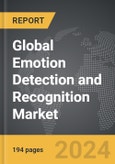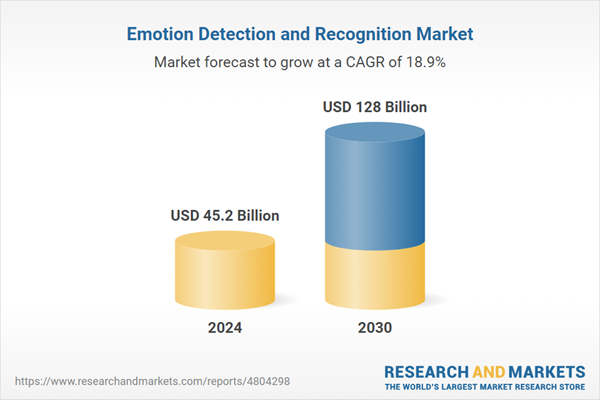The global market for Emotion Detection and Recognition was valued at US$45.2 Billion in 2024 and is projected to reach US$128.0 Billion by 2030, growing at a CAGR of 18.9% from 2024 to 2030. This comprehensive report provides an in-depth analysis of market trends, drivers, and forecasts, helping you make informed business decisions. The report includes the most recent global tariff developments and how they impact the Emotion Detection and Recognition market.
Segments: Technology (Feature Extraction & 3-D Modelling, Natural Language Processing, Machine Learning, Bio-Sensors, Pattern Recognition, Other Technologies); Software Tool (Facial Expression Recognition, Gesture & Posture Recognition, Speech & Voice Recognition).
Geographic Regions/Countries: World; United States; Canada; Japan; China; Europe (France; Germany; Italy; United Kingdom; and Rest of Europe); Asia-Pacific; Rest of World.
The analysts continuously track trade developments worldwide, drawing insights from leading global economists and over 200 industry and policy institutions, including think tanks, trade organizations, and national economic advisory bodies. This intelligence is integrated into forecasting models to provide timely, data-driven analysis of emerging risks and opportunities.
Global Emotion Detection and Recognition Market - Key Trends and Drivers Summarized
How Is Emotion Detection and Recognition Revolutionizing Human-Computer Interaction and Consumer Insights?
Emotion Detection and Recognition (EDR) is revolutionizing human-computer interaction and consumer insights by enabling systems to understand and respond to human emotions, creating more personalized, empathetic, and effective interactions. EDR technology uses advanced algorithms, artificial intelligence (AI), and machine learning to analyze facial expressions, voice tones, body language, and physiological signals to identify a person’s emotional state in real-time. This capability is transforming industries such as marketing, customer service, healthcare, and entertainment by allowing companies to tailor experiences based on individual emotional responses. In marketing, for example, EDR can measure consumer reactions to advertisements or products, providing deeper insights into preferences and behaviors. In healthcare, it can be used to monitor patients’ emotional well-being, offering early detection of mental health issues. The ability to recognize and respond to emotions not only enhances user experiences but also drives better outcomes, making EDR a critical tool in the digital age where understanding human emotions is key to engagement and satisfaction.What Innovations Are Enhancing the Functionality of Emotion Detection and Recognition?
Innovations in Emotion Detection and Recognition are enhancing its functionality through advancements in AI, multimodal data integration, and real-time analytics. One of the most significant developments is the improvement in AI and machine learning models that power EDR systems, making them more accurate in detecting subtle emotional cues across diverse populations. These models are trained on vast datasets that include a wide range of facial expressions, voice patterns, and physiological responses, allowing them to recognize emotions with greater precision. Another key innovation is the integration of multimodal data sources, combining visual, auditory, and physiological signals to create a more comprehensive and reliable assessment of emotional states. For instance, combining facial recognition with voice analysis and heart rate monitoring can provide a more nuanced understanding of whether a person is stressed, happy, or anxious. Real-time analytics is also a crucial advancement, enabling EDR systems to process and respond to emotional data instantaneously, which is vital in applications such as customer service chatbots or interactive gaming environments. These innovations are making EDR technology more robust, versatile, and capable of delivering real-time, actionable insights across a variety of use cases.How Does Emotion Detection and Recognition Impact Customer Experience and Business Strategy?
Emotion Detection and Recognition has a profound impact on customer experience and business strategy by providing deeper insights into consumer behavior and enabling more personalized and empathetic interactions. In customer service, EDR allows companies to gauge customer satisfaction in real-time by analyzing voice tone and facial expressions during interactions, enabling service representatives to adjust their approach to better meet the needs of the customer. This can lead to higher customer satisfaction, increased loyalty, and improved overall service quality. In marketing, understanding the emotional responses of consumers to advertisements, products, or brand messages enables companies to craft more effective campaigns that resonate with their audience on a deeper level. This emotional connection can drive engagement, increase conversion rates, and ultimately enhance brand loyalty. Moreover, in retail environments, EDR can be used to personalize shopping experiences, where in-store cameras and sensors detect customer emotions, triggering tailored product recommendations or promotions. Beyond customer experience, EDR also informs business strategy by providing data-driven insights into how consumers feel about products, services, or brand initiatives, allowing companies to make more informed decisions. By integrating emotion detection into their operations, businesses can create more human-centered strategies that align with consumer emotions, driving better outcomes in both the short and long term.What Trends Are Driving Growth in the Emotion Detection and Recognition Market?
Several trends are driving growth in the Emotion Detection and Recognition market, including the increasing demand for personalized experiences, advancements in AI and machine learning, and the growing focus on mental health and well-being. As consumers increasingly expect personalized and responsive interactions with brands, EDR technology is becoming essential for delivering experiences that resonate on an emotional level. The rise of AI and machine learning is also a significant driver, as these technologies enable more accurate and scalable emotion detection, making it accessible to a wider range of industries and applications. The integration of EDR with other emerging technologies, such as virtual and augmented reality, is expanding its use cases, particularly in gaming, entertainment, and remote communication, where understanding user emotions can enhance immersion and engagement. Additionally, the growing focus on mental health and well-being is propelling the adoption of EDR in healthcare, where it is used to monitor and support patients’ emotional states, contributing to better health outcomes. The increasing use of EDR in remote work and education environments, where it helps gauge engagement and emotional well-being, is also driving market growth. These trends highlight the expanding role of Emotion Detection and Recognition technology in shaping the future of human-computer interaction, customer engagement, and personalized experiences across various sectors.Report Scope
The report analyzes the Emotion Detection and Recognition market, presented in terms of units. The analysis covers the key segments and geographic regions outlined below.Segments: Technology (Feature Extraction & 3-D Modelling, Natural Language Processing, Machine Learning, Bio-Sensors, Pattern Recognition, Other Technologies); Software Tool (Facial Expression Recognition, Gesture & Posture Recognition, Speech & Voice Recognition).
Geographic Regions/Countries: World; United States; Canada; Japan; China; Europe (France; Germany; Italy; United Kingdom; and Rest of Europe); Asia-Pacific; Rest of World.
Key Insights:
- Market Growth: Understand the significant growth trajectory of the Feature Extraction & 3-D Modelling Technology segment, which is expected to reach US$52.0 Billion by 2030 with a CAGR of a 22.1%. The Natural Language Processing Technology segment is also set to grow at 17.7% CAGR over the analysis period.
- Regional Analysis: Gain insights into the U.S. market, valued at $12.3 Billion in 2024, and China, forecasted to grow at an impressive 17.3% CAGR to reach $18.7 Billion by 2030. Discover growth trends in other key regions, including Japan, Canada, Germany, and the Asia-Pacific.
Why You Should Buy This Report:
- Detailed Market Analysis: Access a thorough analysis of the Global Emotion Detection and Recognition Market, covering all major geographic regions and market segments.
- Competitive Insights: Get an overview of the competitive landscape, including the market presence of major players across different geographies.
- Future Trends and Drivers: Understand the key trends and drivers shaping the future of the Global Emotion Detection and Recognition Market.
- Actionable Insights: Benefit from actionable insights that can help you identify new revenue opportunities and make strategic business decisions.
Key Questions Answered:
- How is the Global Emotion Detection and Recognition Market expected to evolve by 2030?
- What are the main drivers and restraints affecting the market?
- Which market segments will grow the most over the forecast period?
- How will market shares for different regions and segments change by 2030?
- Who are the leading players in the market, and what are their prospects?
Report Features:
- Comprehensive Market Data: Independent analysis of annual sales and market forecasts in US$ Million from 2024 to 2030.
- In-Depth Regional Analysis: Detailed insights into key markets, including the U.S., China, Japan, Canada, Europe, Asia-Pacific, Latin America, Middle East, and Africa.
- Company Profiles: Coverage of players such as Affectiva, Appledore, Inc., Brontobyte Analytics, DeepAffects, Electronics and Telecommunications Research Institute (ETRI) and more.
- Complimentary Updates: Receive free report updates for one year to keep you informed of the latest market developments.
Some of the 42 companies featured in this Emotion Detection and Recognition market report include:
- Affectiva
- Appledore, Inc.
- Brontobyte Analytics
- DeepAffects
- Electronics and Telecommunications Research Institute (ETRI)
- Entropik Technologies Pvt. Ltd.
- NaturSoftware
- Nviso SA
- Opsis Pte. Ltd.
- Realeyes
Tariff Impact Analysis: Key Insights for 2025
Global tariff negotiations across 180+ countries are reshaping supply chains, costs, and competitiveness. This report reflects the latest developments as of April 2025 and incorporates forward-looking insights into the market outlook.The analysts continuously track trade developments worldwide, drawing insights from leading global economists and over 200 industry and policy institutions, including think tanks, trade organizations, and national economic advisory bodies. This intelligence is integrated into forecasting models to provide timely, data-driven analysis of emerging risks and opportunities.
What’s Included in This Edition:
- Tariff-adjusted market forecasts by region and segment
- Analysis of cost and supply chain implications by sourcing and trade exposure
- Strategic insights into geographic shifts
Buyers receive a free July 2025 update with:
- Finalized tariff impacts and new trade agreement effects
- Updated projections reflecting global sourcing and cost shifts
- Expanded country-specific coverage across the industry
Table of Contents
I. METHODOLOGYII. EXECUTIVE SUMMARY2. FOCUS ON SELECT PLAYERSIII. MARKET ANALYSISIV. COMPETITION
1. MARKET OVERVIEW
3. MARKET TRENDS & DRIVERS
4. GLOBAL MARKET PERSPECTIVE
UNITED STATES
CANADA
JAPAN
CHINA
EUROPE
FRANCE
GERMANY
ITALY
UNITED KINGDOM
REST OF EUROPE
ASIA-PACIFIC
REST OF WORLD
Companies Mentioned (Partial List)
A selection of companies mentioned in this report includes, but is not limited to:
- Affectiva
- Appledore, Inc.
- Brontobyte Analytics
- DeepAffects
- Electronics and Telecommunications Research Institute (ETRI)
- Entropik Technologies Pvt. Ltd.
- NaturSoftware
- Nviso SA
- Opsis Pte. Ltd.
- Realeyes
Table Information
| Report Attribute | Details |
|---|---|
| No. of Pages | 194 |
| Published | April 2025 |
| Forecast Period | 2024 - 2030 |
| Estimated Market Value ( USD | $ 45.2 Billion |
| Forecasted Market Value ( USD | $ 128 Billion |
| Compound Annual Growth Rate | 18.9% |
| Regions Covered | Global |









